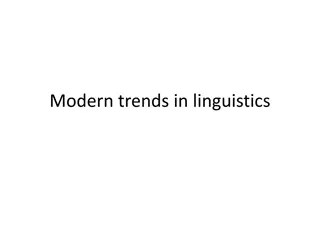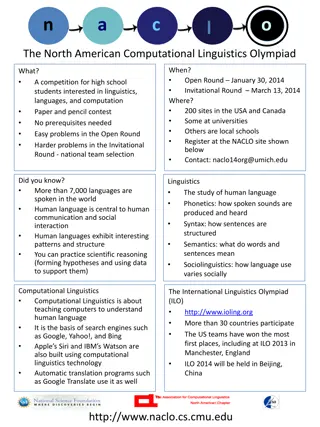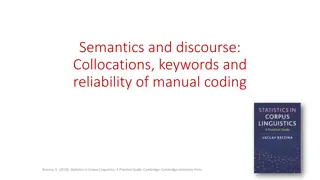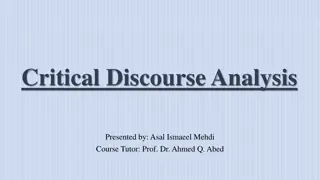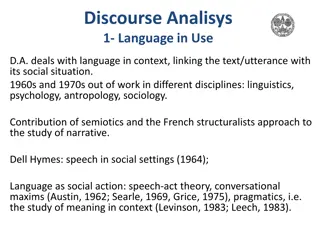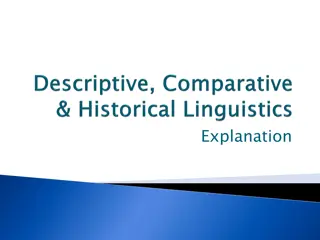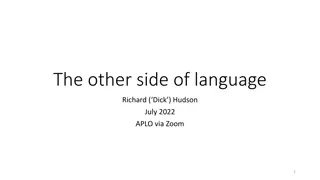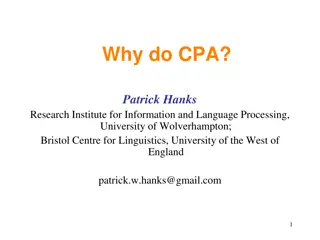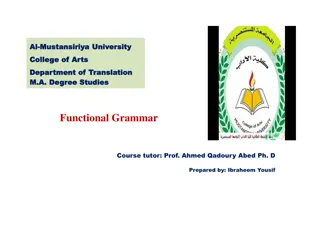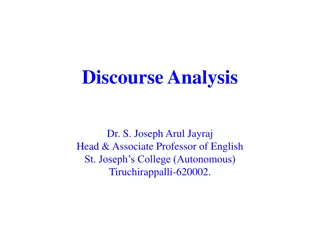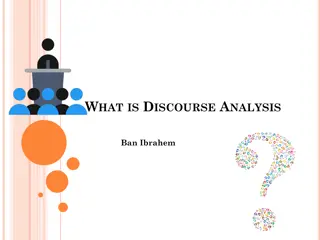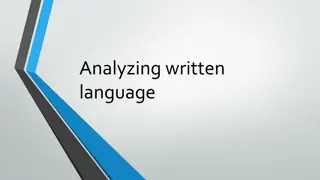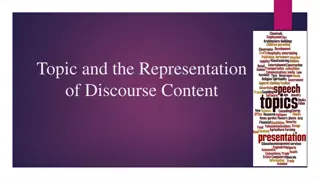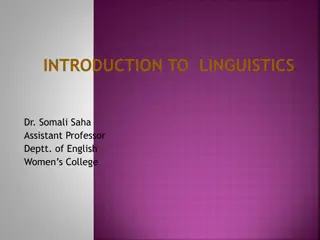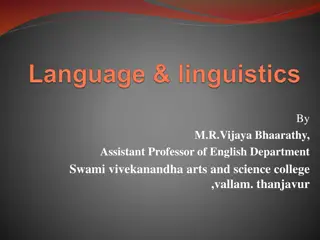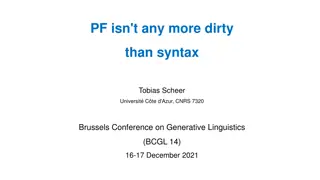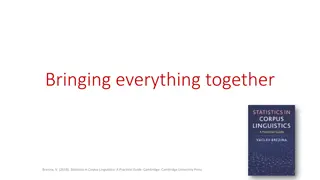Understanding Discourse Structure in Linguistics
Pragmatics explores the relationship between language and the world, while discourse is seen as an interactive totality. Rank structures, as in linguistics, help analyze the grammar of sentences. The Birmingham School of Discourse Analysis pioneered influential studies in this field, focusing on school lessons.
Download Presentation

Please find below an Image/Link to download the presentation.
The content on the website is provided AS IS for your information and personal use only. It may not be sold, licensed, or shared on other websites without obtaining consent from the author. Download presentation by click this link. If you encounter any issues during the download, it is possible that the publisher has removed the file from their server.
E N D
Presentation Transcript
Two Views of Discourse Structure: As Product & as Process Cook Chapter 4 Prepared by Zainab Kareem Ati
Introduction Pragmatics provides us with a means of relating stretches of language to the physical, social, and psychological world in which they take place. Discourse, indeed, might be defined as the totality of all these elements interacting. Yet pragmatics tends only to examine how meaning develops at a given point. It provides us with something like a snapshot of meaning. Discourse is more like a moving film, revealing itself in time sometimes over long periods.
In this figure, we can see Pragmatics as a means of relating stretches of language to the physical, social, and psychological world in which they take place. And Discourse is seen as the totality of all these elements interacting.
Rank structure One way of representing the relationship of parts to a whole is as a rank structure, in which each rank is made up of one or more of the rank below. This type of analysis is used in linguistics, to describe the grammar of sentences. These ranks of grammar are: -Sentence -Clause -Phrase -Word
So the structure of a particular sentence can be represented as in this figure (or tree diagram):
As each element may consist of one or more of the elements of the line below, it is possible for a sentence to consist of a single clause which consists of a single phrase which consists of a single word 'Go!', for example, is at once a sentence, a clause, a phrase, and a word. The idea of rank structure and its representation in tree diagrams can be borrowed from grammar and applied to discourse. If we regard a three-volume series of books as a complete discourse, for example, we can render its structure as in the following figure:
The Birmingham School of Discourse Analysis A pioneering and influential study in this field was carried out at the University of Birmingham by Sinclair and Coulthard(1975). To teachers, it is of particular interest not only because it provides a model which might be applied with modifications to discourse in general, but also because the discourse type it chose to analyze was school lessons. Sinclair and Coulthard recorded a number of British primary school lessons. On the basis of these data, they proposed a rank structure for these lessons as follows: -Lesson -Transaction -Exchange -Move -Act
From their data, Sinclair and Coulthard identified a finite number used by the teachers and pupils and gave each one a code. They then drew up rules, based on the data, showing how these acts are combined together to form moves and how moves combine to form various kinds of exchange--rather as grammarians formulate rules describing how words combine into phrases, or phrases into clauses. One kind of exchange, which they called a teaching exchange, for example, consisted of between one and three moves: Opening (Answering) (Follow-up) (An element within brackets here is optional.) Going down to the next layer, each of these moves consists of specified acts as in the next figure:
The Birmingham School approach has since been applied to many different discourse types: for example, medical consultations (Coulthard and Montgomery 1981b) and TV quiz shows (Berry 1981) The importance of such approaches for the language learner is that if people involved in communication know, even subconsciously, of the structures of various discourse types and the way they develop, then this tacit knowledge may enable them to communicate successfully. The primary school pupils studied by Sinclair and Coulthard had acquired such a knowledge of the way lessons develop; the participants in a trial know what stage it is in and can organize their behavior accordingly. Because such structures are 'conventional, and hence culturally variable' (van Dijk and Kintsch1983: 16) the language learner, in order to be able to operate effectively as a participant in discourse, needs to be able both to identify what type of discourse he or she is involved in, and to predict how it will typically be structured.
The discourse types to which this approach is most easily applied tend to have certain features in common. They are all rather formal and ritualistic, and feature one participant with the institutionalized power to direct the discourse. This person may well plan the development of the discourse in advance within the fairly narrow limits of the social conventions for that discourse type. There are cases where participants depart from the plans and conventions, of course. This is sometimes interpreted as insubordination, crime, madness, immaturity, or ignorance; sometimes as a sign that the speaker is foreign- and sometimes as creativity!
Discourse typology: spoken and written; formal and informal The Birmingham School approach examines spoken discourse, seeking to interpret it in terms of a rank structure and showing that when it is analyzed after the event, there is more order and form in it than might at first be apparent. We need now to assess the validity of this approach, to see whether it can be extended to other kinds of discourse, and to examine alternative approaches too. As a preliminary we shall begin to examine the problem of how different kinds of discourse can be categorized, and the parameters which are best used to distinguish them.
Traditionally, language teaching has divided discourse into two major categories, the spoken and the written, further divided into the four skills of speaking and listening, writing and reading. Many courses try to provide a balanced coverage. Spoken discourse is often considered to be less planned and orderly, more open to intervention by the receiver. There are some kinds of spoken discourse, however-like lessons, lectures, interviews, and trials-which have significant features in common with typical written discourse. As we have seen in the summary of the Birmingham School approach, these kinds of spoken discourse are also planned, and the possibilities for subordinate participants can be severely limited.
It is clear that in reading a novel one cannot influence its development (that can be the pleasure or pain of reading), but it is almost equally hard for a criminal to influence the direction of a trial, or for a primary school pupil to prevent the lesson progressing as the teacher intends. Conversely, there are times when readers do have rights to affect written discourse. Writers respond to the market. Teachers send essays back to be rewritten. The editors of this book may ask me to cut out this sentence.
The traditional division of language into the spoken and the written is dearly and sensibly based on a difference in production and reception: we use our mouths and ears for one, and our than an eyes or the other. Yet as far as discourse structure is concerned, a more fundamental distinction seems to be between formal, planned discourse, which may be either written or spoken, and less formal, unplanned discourse which-though it may also be either written or spoken-is usually associated with speech. Informal spoken discourse is something in which the modem foreign language learner, with opportunities for travel and social contact, .is most likely to wish to succeed, but also the discourse type he or she is likely to find hardest, precisely because it is so informal and unpredictable.
It is a common and enormously frustrating experience for foreign language learners, presented with the opportunity to participate in authentic conversation with native speakers, to fail to join in successfully, despite having a high level of proficiency in the classroom . Conversation is fast, and to some extent this failure of the foreign language learner can be attributed to the slow processing of language knowledge. By the time the learner has formulated something to say, the conversation has moved on. Yet there are other reasons too.
Conversation as a Discourse Type The term Conversation is widely used in non-technical sense and people seem capable of distinguishing it from other kinds of talk ,we shall define the term as follows but these definitions are imprecise : 1. It is not primarily necessitated by a practical task . 2. Any unequal power of participants is partially suspended 3. The number of participants is small (there is no fixed number of participants at which conversation becomes impossible but although a conversation can take place between five people it cannot take place between a hundred) 4. Turns are quite short (there is no fixed length for turns in conversation ,and sometimes one participant holds the floor for some time; yet although we might call a turn of four minutes part of a conversation, we would consider conversation to have ceased if someone talked for an hour and a half) 5. Talk is primarily for the participants and not for an outside audience. Nevertheless ,the definitions are useful despite their imprecision.
Conversation analysis Is a branch of study which sets out to discover what order there might be in this apparent chaos . It is associated with group of scholars in the USA known as ethnomethodologists They try to impose large structures on what is happening from the outset They began at the most local level, trying to see how participant in interaction handle a conversation They proceed very much from the bottom-up trying to establish the smallest units fist They regard work like that of sinclair & coulthard as over hasty premature formalization rather than wait until a discourse is finished and they analyze it as a whole from outside and with the benefit of hindsight. The ethnomethodologists try to understand how it unfolds in time They view discourse as a developing process rather than a finished product; and this after all is how the participants must be handling it and making sense of it .
Turn-taking Conversation involves turn- taking and that the end of one speaker s turn and the beginning of the next's frequently latch on to each other with almost perfect precision and split-second timing (Sacks, Schegloff, and Jefferson 1974) Overlap of turns occurs in only about 5 per cent of conversation or less, strongly suggesting that speakers somehow know exactly when and where to enter (Ervin-Tripp 1979) They signal to each other that one turn has come to an end should begin . Where there is no overlap between turns it has some particular significance :signaling annoyance, urgency ,or a desire to correct what is being said. and another
Turn taking mechanism ,the way in which speakers hold or pass the floor, vary between cultures and languages. There are certain signals shows that the speaker get into or out of a conversation ,or passing the term to somebody else . Turn taking involves factors which are not linguistics, like eye contact and body position and movement, intonation and volume contribute. The relative status of the speakers, or the role which one of playing are also important. Also the position and power : like politician speech and when the professor speaks ,the students listen . them is
Turn Types The adjacency pair : this occurs when the utterance of one speaker makes a particular kind of response very likely. A greeting for example is likely to be answered by another greeting , and if not it is somehow rudeness or lack of attention . 1- Offer Acceptance (preferred) Refusal(dispreferred) 2-Assesssment Agreement(preferred) Disagreement(dispreferred) 3-Blame Denial( preferred) Admission( dispreferred )
4- Question Expected answer ( preferred ) Unexpected answer ( dispreferred ) A dispreferred response is marked by slight pause or words like well see . Insertion sequence :in which one question and answer pair contains another . A: Did you enjoy the meal ? B: Did you ? A: yes B: So did I
Side sequence :in which speaker simply switch from one topic to another unrelated one ,and then back again . A: I m dying to know where s my watch by the way ? B: what? A:what Gillian's aerobics session are like HA HA HA B:what sessions? It's here A:Gillan does aerobics sessions every evening. LEADS them . Thanks. can you imagine. We have types of clarification : Repair: a phenomenon in which participants correct either their own words or those of another participant, edging towards a situation in which maximum communication is achieved.
Mutual formulation: this kind of the right amount of information for communication to take place is very common in conversation, particularly where times or places or objects need to be specified. Gist or upshot :when the speaker goes back over, or summarizes the literal meaning of what has been said . What is the speaker is trying to do with his words ,ex: I ll just go over the main points again. Pre-sequence: participants in a conversation draw attention to the kind of turn they are going to take next . Like the markers teachers use to signal transitions in lessons Right or OK to get started . Examples like pre- request , pre- invitation .
These devices are used for obtaining the right to a longer turn like a story E.g. the clich d opening of jokes : Have you heard about the .. Or personal anecdotes : Listen ! Do you know what happened to us last night ? If a right to a longer turn is obtained its ending must also signaling so that the other participants know it is finished and a contribution from them will not be an interruption, like pauses ,particular kinds of laughter and filler words like anyway so these bring us to another turn . We have also a special mechanism of closing a conversation ,In British and North American English this consist of pre-sequence impending closure followed by farewells , sometimes it would be construed as rudeness .
Discourse as a process : Ethnomethodology depicts conversation as discourse constructed and negotiated bet the participants, following pre-established patterns, and marking the direction they are taking in particular ways: with pauses, laughter, intonations, filler words, and established formulae. Culture specific rules and procedures of turn-taking provide ample breeding ground for misunderstanding. Entering and leaving conversation, bidding for a longer turn, refusing without appearing rude, changing the topic, are all notoriously difficult for foreign learners: tasks for which the language classroom, where turns are patiently organized and controlled by the teacher, has hardly prepared them. Indeed the teacher who constantly interrupts the students discourse to correct every grammatical mistake not only violates usual turn-taking procedures but may also hinder the students acquisition of them.
To sum up The two approaches to discourse which have been considered may seem irreconcilable and applicable to very different kinds of interaction. The Birmingham school has dealt only with formal discourse, and with large structures which become evident after the event; the ethnomethodologies have eschewed these large structures and concerned themselves with local transitions and only with casual conversation.
Thank You Thank You



